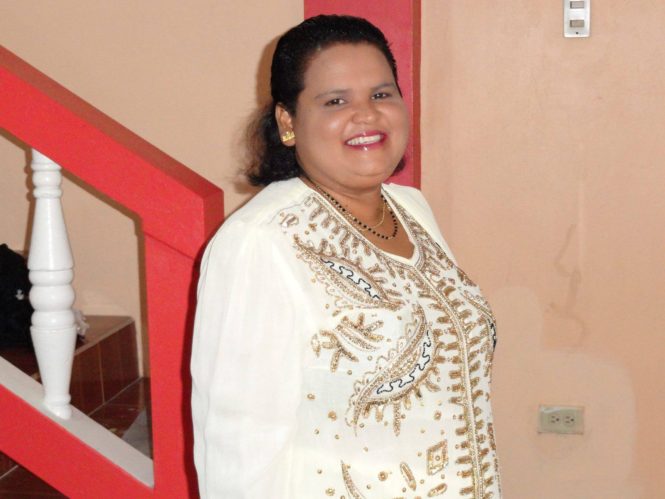Rasika gestured towards the page in her hand.
“Seven verses! You mad? You think people here going to stop and listen to all that? Here you does sing two lines to ketch them and buss it.”
Rasika Dindial, the ‘Rani’ of Chutney, squinted at the 26- year-old girl as if she had lost her mind. “And look at all these cuss words! Nah! I not singing dat,” she declared in a tone of finality, passing the page back to the girl. “Screwed up? I can’t sing ‘screwed’! How you want me to use that word!” The line she was referring to was “My loveless and luckless and screwed up piya (lover) ”.
Her horror was clearly not feigned.
“Ok we’ll change it,” said the girl, Sneha Khanwalkar, with a mischievous smile. One phone call to her lyricist in Bombay and the necessary adjustments were approved, including reducing the number of verses in the song and changing the offending ‘screwed up’ to ‘messed up.’
They resumed recording. Rasika’s powerful and melodious folk voice belted out ‘Electric Piya’. The musical composition, a slight variation of the 1950’s “breakaway’ song Babhana Aawe Jaaye originally rendered by the Surinamese singer Ramdew Chaitoe, had been a popular number among the Indian population in Trinidad at that time. ‘Breakaway’ songs were so called owing to the spicy, danceable nature of the music that caused listeners to, as Trinidadians styled it, ‘break away.’ It meant throwing off all self-consciousness to permit oneself to dance and have a good time. The lyrics of breakaway songs ranged from the religious to narratives about daily life, the common feature being the exciting dholak beat. The themes were similar to the popular, commercialised Chutney music that later developed out of this breakaway tradition and even gave birth to the ‘sokah’ or ‘soca’ as all Trinidad – and, hopefully, other parts of the world – now know it. Some older singers might say that Chutney always existed; what has happened is that somebody gave it a formal name to make it marketable.
Electric Piya had been penned for Anurag Kashyap’s film The Gangs of Wasseypur. The film, which runs for a total of six hours, is to be released in two parts. It is set in Dhanbad, a city in the state of Jharkhand. Dhanbad is also known as the ‘Coal Capital of India.’ Based on a true story, the first part, Wasseypur, is set in 1941, the year that marked the beginning of the coal mafia in India. Part II, Gangs of Wasseypur, takes the narrative all the way to 2004. The film tells the story of successive generations of a coal mafia family from pre-independence India into the new millennium.
Winner of the 2011 R.D. Burman Filmfare Award for Best Promising Newcomer, Khanwalkar had come to Trinidad in search of the music with which she had become fascinated since her college days. The fourth female music director to pass through the Bollywood film industry, this was her first time out of India. Her travel to Trinidad was rooted in a combination of curiosity and her quest to discover new sounds. Furthermore, The Gangs of Wasseypur was set within the region from which many of Trinidad’s East Indian indentured labourers had come, making the island fertile ground for her research.
“Anurag had first offered me a film in which he required jazz music,” she explained. “Since I hadn’t studied that, I was hesitant to do it. Then he offered one that was based on Bihari folk and, when I read the script, I decided I wanted to come to Trinidad to do the research. I knew that many of the Indians who live here now are descendants of the indentured workers who had come here from the same area in which the film is set. About three months before this I had been playing with the idea of coming to Trinidad because I had taken a liking to chutney so I immediately suggested this after I read the script. He made no fuss and allowed me the freedom to do whatever I wanted to.”
“But why Trinidad?” I asked. “You could have gone to some other island like Guyana or Suriname. They have Chutney music there also.”
“See? I had found it fascinating that these Indians had come here in the 19th century,” she responded, “and I wanted to see what a hundred years had done. Although so many years had passed, the songs remained with them though they had changed. It’s like having some ancestor of mine who spoke Jamaican like “Yah, mon” although she was Indian, you know. I found it really intriguing so I just wanted to see.
“Also Sonny Mann’s Lotay La was a really big hit with my classmates back at college in India and he was from Trinidad,” she continued. “When I heard it, I went looking for more Chutney music on the Internet and that’s how I found out about Trinidad. The one that I liked was Tote He and I made all my friends learn it. I know every word of that song. Now that I’m here I recently learned what it means, but back then, it was just a catchy piece.”
She laughed and started singing Tote He but her Indian accent gave the song an even more humorous finish; it definitely didn’t have the Trinidadian ring to it.
I rolled my eyes.
She laughed. “C’mon, yaar (a word meaning “friend”), you have to admit, it’s catchy. I think these guys here are doing some interesting things with this.
“So,” she said, rocking back in her chair, “I want to get some really dirty Chutney music. You think I’ll get someone to sing a really dirty one for me?” she asked.
“You just sang Tote He for me, didn’t you? Are you really serious about that question? Will you get someone to sing a dirty one for you?”
“Yeah, yeah, I mean, like dirty dirty. Oh! alright,” she said catching on to what I had just said, “Yeah, yeah, okay. Who do you recommend?”
I sighed. “Well you could try any number of them. I’m sure any one of the younger ones would be delighted to sing for you.”
She eventually decided on Chutney singers Vedesh Sookhoo (of Dhal Belly fame) and Nigel Salickram, who doubled as a ventriloquist.
Sneha’s work is characterized by her use of folk music in which she reworks the folk aesthetic to create a modern but raw, realistic sound. She rarely opts to work with the well-known playback singers. Instead, as she did in the case of Dindial, she uses the earthy voices of the folk singers and reworks modern music around them. Her aim is to create a different sound from the one heard in the more commercial popular films being churned out by Bollywood. The work of Kashyap and Dibaker Banerjee do not fit into mainstream Bollywood and Sneha fits perfectly with these directors in her movement away from the mainstream.
Whatever the setting of the film, Sneha would go into the depths of the regions to search out songs and singers who best represent the feelings she was attempting to create in her music. Her earlier work for the Kashyap film, Oye Lucky Lucky Oye!, led her to the interiors of Punjab where she went looking for a particular song which her director had requested.
In an interview, director Dibaker Banerjee, described her as someone who could take a backpack, go into any ‘village, God-forsaken areas, etc and get inside the musical soul of that area and come out with melodies.’ That was precisely what Sneha did in Trinidad. She chose to stay in an area of Barataria, where she was close to the ordinary folk and able to draw from their musical experiences. By her second week in Trinidad, her search for Chutney music had taken her into the soul of Trinidadian music, with sounds ranging from the Indo-Trinidadian folk voices of Rasika Dindial, Vedesh Sookhoo and the late Sagar Sookraj, to steelpan and parang.
Four tracks that feature the music she has collected from Trinidad have been contextualized in song to suit a rural Indian, Bihari aesthetic. Dindial’s voice is featured in the track ‘Electric Piya’ while ‘Hunter,’ penned by Varun Grover and sung by Vedesh Sookhoo, features another track in which Sneha has added other singers from India, to render the Bhojpuri part of the song.
A third track, “Moorah Calypso,” recorded by Trinidad’s Robert Persaud, features the cuatro, mandolin and tambourine and has been reworked in India to give the sense of an acoustic feel of the village on an afternoon. “Bhoos,” (translated as “Hay”), also recorded by Persaud and reworked in India, aimed at featuring what Sneha describes as “aggressive parang” perhaps a relevant adaptation to the mood of a film that has, as its central focus, a gangster theme set against the grimness and violence surrounding the Dhanbad coalmines.
The entire soundtrack of Gangs of Wasseypur will be familiar to Indo-Trinidadians attuned to the folk musical sound. The song “Hunter”, featuring lead vocals of Trinidadian Chutney singer Vedesh Sookhoo can be heard on the youtube Gangs of Wasseypur song list, along with such tracks like “Tain Tain ToTo” that echo the unmistakable sound of Trinidad. In May 2012, the five-hour film met with favourable reviews at the 65th Cannes Film Festival in France where it had its international screening. The India release is set for June 22. Since the film does not conform to the mainstream Bollywood fare that is part of the Indo-Trinidadian’s entertainment menu, it may not reach the screens of Trinidad and Tobago’s cinemas but we have much to look forward to in it if it is released here. A portion of the sound track promises to be an exciting re-interpretation of music that Trinidadians regard as commonplace, our familiar sounds repackaged and re-presented to us in feelings ranging from the sensual to the aggressive.
Sneha Khanwalkar’s music holds up a mirror before us T&Tans, enabling us to see the possibilities that we rarely recognize as we seek external validation of our hidden creative selves. For the Indo-Trinidadian, Sneha’s attraction to and use of Chutney music represents confirmation of the great creativity of a culturally marooned people who have found the wherewithal to utilize their synergies to create an entirely new form.
Credit: https://www.caribbeanreview.org/2017/08/when-chutney-goes-bollywood/
Donate
Please consider Donating to keep our culture alive



Leave a Reply
You must be logged in to post a comment.